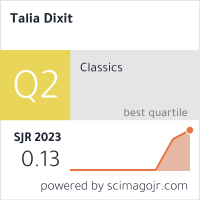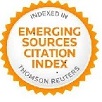Nestore oratore nell' Iliade: strategie del narratore, posizioni del personaggio
Palabras clave:
Agamenón, Autoridad, Código heroico, Oratoria, Ilíada, Néstor, PolíticaResumen
L’autorità e l’abilità oratoria di Nestore, lodate dal narratore, lo rendono protagonista nel dibattito sull’autorità di Agamennone. Nel contesto dei discorsi pronunciati in assemblea nel I e nel IX libro dell’Iliade è possibile seguire la posizione di Nestore rispetto a tale questione politica. Essa rimane costante tanto nei contenuti quanto nel ricorso a precisi stilemi oratori, i quali sembrano veicolare istanze d’autorità originali nella loro opposizione all’uso arbitrario del potere da parte di Agamennone, così come nel ruolo fondante attribuito ad una azione che sia comunitaria a livello decisionale e d’interesse.
Descargas
Referencias
ADKINS, A.W.H. (1960), Merit and Responsability, a Study in Greek Values, Oxford: University Press.
____ (1982), ‘‘Values, goals, and emotions in the Iliad’’, Classical Philology, 77, 292- 326.
____ (1987), ‘‘The ‘morality’ in Homer’’. Classical Philology, 82, 311-322.
ALDEN, M. (2000), Homer Beside Himself. Para-narratives in the Iliad, Oxford: University Press.
ANDERSEN, Ø. (1978), Die Diomedesgestalt in der Ilias,Symbolae Osloensens Vol. Suuppl. 25, Oslo: Universitetforlaget.
____ (1987), Myth, Paradigm and ‘Spacial Form’ in the Iliad, in J. M. Bremer, I. de Jong and J. Kalff (eds.), Homer: Beyond Oral Poetry, Recent Trends in HomericInterpretations, Amsterdam: Grüner, pp. 1-13.
ANDREWS, A. (1961). ‘‘Phratries in Homer’’, Hermes, 89, 129-140.
ARENDT, W. (1933), Die typischen Szenen bei Homer, Berlin: Weidmann.
AUSTIN, N. (1966), ‘‘The Function of Digression in the Iliad’’, Greek, Roman, Bizantin Studies, 7, 337-354.
BREMER, J., DE JONG, I. and KALFF, J. (1987), Homer Beyond Oral Poetry: Recent Trends in Homeric Interpretations. Amsterdam: Grüner.
CAIRNS, D. (1993), AIDOS, The Psychology and Ethics of Honour and Shame in Ancient Greek Literature, Oxford: University Press.
____ (2004), ‘‘The Iliad as Politics. The Performance of Political Thought by D. Hammer, Oklahoma 2002’’ (rev.), The Classical Journal, 99, 345-349.
COLDSTREAM, J. N. (1983), ‘‘Gift Exchange in the Eight Century B.C.’’, in R. Hägg (ed.), The Greek Renaissance of Eight Century B.C.: Traditions and Innovations,Stockholm: Aström, pp. 201-206.
COMBELLACK, F. (1948), ‘‘Speakers and Sceptres in Homer’’, The Classical Journal, 43, 209-17.
DE JONG, I. (1985), ‘‘Iliad 1, 366-392: A Mirror Story’’,Arethusa, 18, 5-22.
____ (1987), Narrators and Focalizeres: The Presentation of the Story in the Iliad. Amsterdam: Grüner.
DELAUNOIS, M. (1952), ‘‘Comment parlent les héros d’Homère’’, Les Études Classiques, 20, 80-92.
____ (1959), Le plan rhétorique dans l’eloquence grecque d’Homère à Demosthènes, Bruxelles: Palais des Académies.
DENNISTON, J. D. (19542), The Greek Particles, Oxford: University Press.
DENTICE DI ACCADIA, S. (2005), ‘‘Nestore, oratore deliberativo o encomiastico? L’orazione di Nestore nel I libro dell’Iliade nella critica antica’’, Atene e Roma, 50, 145-161.
DI BENEDETTO, V. (1994), Nel laboratorio di Omero, Torino: Einaudi.
DICKSON, K. (1990), ‘‘A Typology of Mediation in Homer’’, OralTradition, 5, 37-71.
____ (1992), ‘‘Orality and Auctoritas in Homer’’,Humanitas, 16, 28-35.
____ (1995), Nestor: Poetic Memory in Greek Epic, New York: Garland.
DODDS, E. R. (1951), The Greeks and The Irrational, Berkeley: California University Press.
DONLAN, W. (1979), ‘‘Thestructure of Authority in the Iliad ’’, Arethusa, 12, 51-57.
____ (1982) ‘‘The Politics of Generosity in Homer’’, Helios, 9:1-15.
EASTERLING, P. E. (1989). ‘‘Agamemnon’s Skeptron in the Iliad’’, in M. M. Mackenzie and C. Roueché (eds.), Images of Authority, Cambridge: University Press, pp. 104-121.
EASTON, E. (1959). ‘‘Political Anthropology’’, in B. J. Siegal (ed.), Biennial Review of Anthropology, Stanford: University Press, pp. 210-262.
EDWARDS, M. W. (1991), Style, in G. S. Kirk (ed.), The Iliad: a commentary, V: Books XVII-XX, Cambridge: University Press, pp. 42-60.
ERBSE, H.(1969), Scholia Graeca in HomeriIliadem (scholia vetera), rec. H. Erbse, vol. 1, Berlin: de Gruyter.
FINKELBERG, M. (1998). ‘‘Time and Arete inHomer’’, The Classical Quarterly, 48, 14-28.
FINLEY, M. I. (19772). The World of Odysseus, New York: Chatto & Windus.
FRÄNKEL, H. (1954). ‘‘L’esametro di Omero e di Callimaco’’, trad. ital in M. Fantuzzi e R. Pretagostini (edd.: 1995), Struttura e storia dell'esametro greco, Roma: Gruppo Editoriale Italiano, vol. 2, pp. 173-269.
FRIED, M. H.(1967), The Evolution of Political Society: An Essay in Political Anthropology. New York: Random House.
FRIEDRICH & REDFIELD, R., J. (1978), ‘‘Speech as a Personality Symbol: The Case of Achilles’’, Language, 54, 263-88.
GILL, C. (1996), Personality in Greek Epic, Tragedy, and Philosophy: the Self in Dialogue, Oxford: University Press.
GRIFFIN, J. (1980), Homer on Life and Death, Oxford: University Press.
____ (1986), ‘‘Homeric Words and Speakers’’, Journal of Hellenic Studies, 106, 36-57.
____ (1995), Homer, Iliad. Book nine, ed. by Jasper Griffin, Oxford: University Press.
____ (2004), ‘‘Speeches’’, in R. Fowler (ed.) The Cambridge Companion to Homer, Cambridge: University Press, pp. 156-169.
GSCHNITZER, E. (1978), Storia sociale dell’antica Grecia, ed. italiana a cura di L. Gallo e M. Corsaro (1988), Bologna: Il Mulino.
HAINSWORTH, B. (1993), The Iliad : a commentary, vol. 3: Books 9-12/ introd. & comm.by Bryan Hainsworth, ed. by G. S. Kirk, Cambridge: University Press.
HAMMER, D. (1998), ‘‘Politics in the Iliad’’, TheClassical Journal, 94, 1-30.
____ (2002), The Iliad as Politics: the Performance of Political Thought. Oklahoma: University Press.
HAVELOCK, E. (1978), The Greek Concept of Justice: From Its Shadow in Homer to Its Reality in Plato, Cambridge: University Press.
IGLESIAS ZOIDO, J.C. (2000), “Oratoria, retórica y escritura en Grecia”, Cuadernos de Filología Clásica. Estudios Griegos e Indoeuropeos, 10, 39-70.
INGALLS, W. (1982), ‘‘Linguistic and Formular Innovation in the Mythological Digressions in the Iliad’’, Phoenix, 36, 201-208.
KARP, A. (1977), ‘‘Homeric Origins of Ancient Rhetoric’’, Arethusa, 10, 237-58.
KENNEDY, G. A. (1957), ‘‘The Ancient Dispute over Rhetoric in Homer’’, The American Journal of Philology, 78, 23-35.
____ (1963), The art of persuation in Greece, Princeton: University Press.
KIRK, G. S. (1971), ‘‘Old Age and Maturity in Ancient Greece’’, Eranos, 40, 123-58.
____ (1985), TheIliad: a commentary, vol. 1: Books 1-4/ introd. & comm. by G. S. Kirk, Cambridge: University Press.
LARDINOIS, A. P. (2000), ‘‘Characterization through gnomai in Homer's « Iliad »’’, Mnemosyne, 53, 641-661.
LATACZ, J. (2000), Homers Ilias : Gesamtkommentar/ auf der Grundlage der Ausgabe von Ameis-Hentze-Cauer (1868-1913) hrsg. von Joachim Latacz. 1, Erster Gesang: (A). 2Kommentar/ von Joachim Latacz, René Nünlist, und Magdalene Stoevesandt, München: Saur.
LÉTOUBLON, E. (1994), “Le bon orateur et le génie selon Antenor dans l’Iliade: Ménélas et Ulysse”, in J. M. Galy et A. Thyvel (eds.), La rhétorique grecque, Paris: C.I.D. Diffusion.
LIÑARES, L. A. (1999), ‘‘Néstor locutor y protagonista en la « Ilíada » : referencias discursivas’’, Eclás, 116, 15-35.
LLOYD-JONES, H. (1971), The Justice of Zeus, Berkeley: University Press.
LOHMANN, D. (1970), Die Komposition der Reden in der Ilias, Berlin: de Gruyter.
LOUDEN, B. (2006), The Iliad: Structure, Myth, and Meaning, Baltimore: John Hopkins University Press.
LYNN-GEORGE, M. (1988), Epos: World, Narrative and the Iliad, London: MacMillan.
MARTIN, R. P. (1989), The Language of Heroes. Speech and Perfomance in the Iliad. Ithaca: Cornell University Press.
MCGLEW, J. (1989), ‘‘Royal Power and the Achean Assembly at Iliad 2.84-393’’, Classical Antiquity, 8, 283-295.
MINCHIN, E. (1991), ‘’Speaker and listener, text and context: some notes on the encounter of Nestor and Patroclus in Iliad 11’’, The Classical World, 84, 273-285.
NAGY, G. (1979), The Best of the Acheans: Concepts of the Hero in Archaic Poetry, Baltimore: John Hopkins University Press.
ONIANS, R. B. (1951), The Origins of European Thought about the Body, the Mind, the Soul, Time and Fate, Cambridge: University Press.
PEDRICK, V. (1983), ‘‘TheParadigmatic Nature of Nestor’s Speech in Iliad 11’’, Transactions of the American Philological Association, 113, 55-68.
PELLING, C. (ed.) (1990), Characterization and individuality in Greek Literature,Oxford: University Press.
PULLETYN, S. (1995), Homer, Iliad. Book one; ed. by S. Pulletyn, New York, Oxford: University Press.
RADCLIFFE-BROWN, A.R.(1940) ‘‘Preface’’, in M. Forter and E. E. Evans-Pritchard (eds.), African Political System, Oxford: University Press, pp. xi-xxiii.
____ (1952), Structure and Function in primitive Society, London: Cohen and West: Routledge and Keagan Paul.
RAAFLAUB, K. (1989), ‘‘Homer and the Beginning of Political Thought in Greece’’, Proceedings of the Boston Area Colloquium Series in Ancient Philosophy, 4, 1-25.
RICHARDSON, S. (1990), The Homeric Narrator, Nashville: Vanderbilt University Press.
ROISMAN, H. M. (1988), ‘‘Nestor’s Advice and Antilochus’ Tactics’’, Phoenix, 42, 114-120.
____ (2005), ‘‘Nestor, the Good Counselor’’, The Classical Quarterly, 55, 17-38.
____ (2007), ‘‘Right Rhetoric in Homer’’ in I. Worthington (ed.), A Companion to Greek Rhetoric, Oxford: University Press, pp. 429-446.
ROSE, P. (1988), ‘‘Thersites and the Plural Voices of Homer’’, Arethusa, 21, 5-25.
SEGAL, C. (1971), ‘‘Nestor and the Honor of Achilles’’, Studi Micenei ed Egeo-Anatolici, 13, 90-105.
SCHMID, W., STHÄLIN, O.(1929), Geschichte der griechischen Literatur, Munchen: Beck.
SCHOFIELD, M. (1986), ‘‘Eubulia in the Iliad’’, The Classical Quarterly, 36, 6-31.
SNELL, B. (1948), Die Entdeckung des Geistes: Studien zur Entstehung des europäischen Denkensbeidem Griechen, Hamburg: Claassen und Goverts.
SNELL, B. et al. (1955-2010), Lexikon des frühgriechischen Epos, Göttingen: Van den Hoeck & Ruprecht.
SOLMSEN, F. (1954), ‘‘The gift of speak in Homer and Hesiod’’, Transactions and Proceedings of the American Philological Association, 85, 1-15.
TAPLIN, O. (1990), ‘‘Agamenmnon’s Role in the Iliad’’, in C. Pelling (ed.) Characterization and individuality in Greek Literature, Oxford: University Press, pp. 60-82.
____ (1992), Homeric Soundings: The Shaping of the Iliad, Oxford: University Press.
TOOHEY, P. (1994), Epic and Rhetoric, in I. Worthington (ed.), Persuasion: Greek Rhetoric in Action, London: Routledge, pp. 153-161.
TURNER, V. (1974), Dramas, Fields and Metaphors: Symbolic Action in Human Society, London, Ithaca: Cornell University Press.
____ (1986), The Anthropology of Performance, New York: PAJ Publications.
WEST, M. L. (1998), The East Face of Helicon: West Asiatic Elements in Greek Poetry and Myth. Oxford: University Press.
____ (2007), Indo-European Poetry and Myth, Oxford: University Press.
WILAMOWITZ-MOELLENDORF, U. (1916), Die Ilias und Homer, Berlin: Weidmann.
WILLCOCK, M. (1964), “Mythological Paradeigmata in the Iliad”, The Classical Quarterly, 14, 141-154.
____ (1977), ‘‘Ad hoc Invention in the Iliad’’, Harvard Studies in Classical Philology, 81, 41-53.












